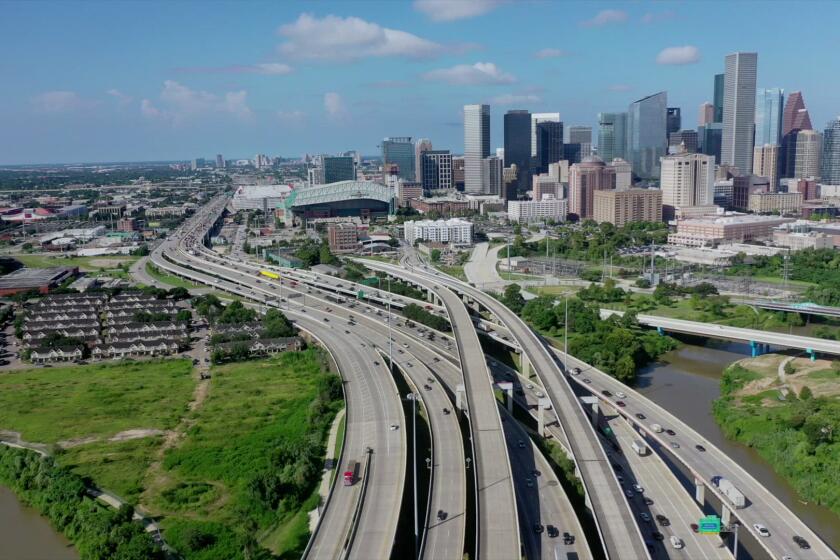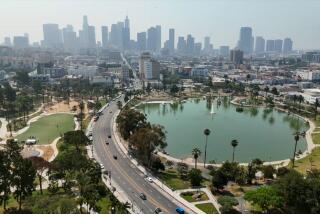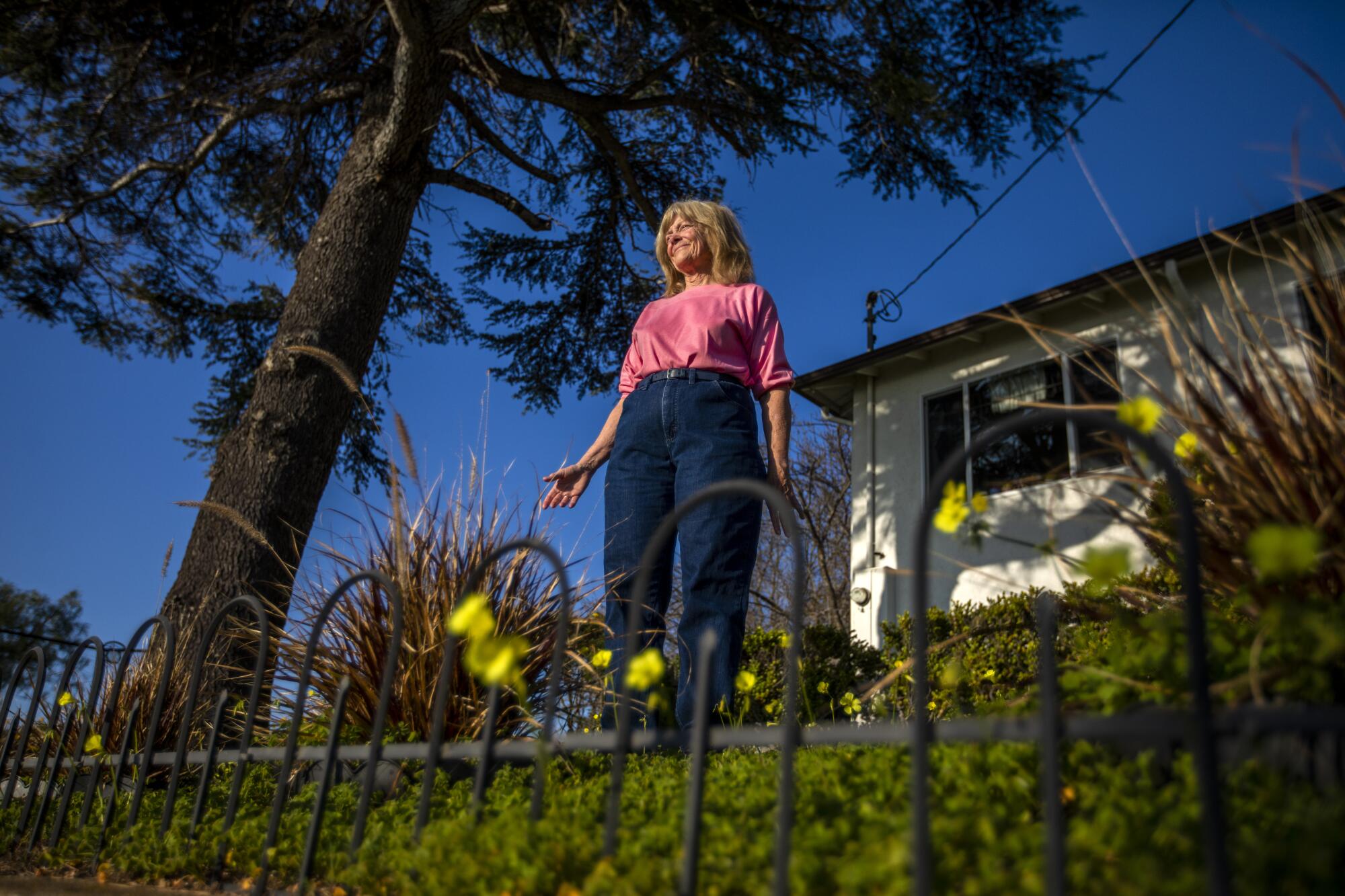
- Share via
HAYWARD, Calif. — Eight lanes of freeway would be slicing through what’s now Debbie Frederick’s house if everything had gone to plan.
Instead, the retired nurse practitioner gazes through her home’s picture windows on clear afternoons to take in a vast sweep of the San Francisco Bay. With binoculars, she can spot a spire of the Golden Gate Bridge 30 miles away.
She had rented this three-bedroom stucco house in the East Bay city of Hayward for nearly a quarter century when, just over a decade ago, her absentee landlord, the state of California, finally gave up on plans to build the proposed 238 Freeway.
The state began selling off hundreds of properties, and, in 2013, Frederick bought the house for $250,000.
“I’m sitting on a gold mine by accident and good luck,” she said.
Her real estate coup marked a happy ending in one of the many decades-long battles that blighted swaths of cities around the nation: roads that were planned but never built.
“The narrative is that highways that were built ruined cities,” said Emily Lieb, a Seattle-based historian who has studied the legacy of such projects. “But no, it’s that highways that were planned ruined cities. There is no highway, but there certainly is a scar.”

More than 1 million people were forced from their homes nationwide in the first two decades of interstate construction, starting in the late 1950s, and urban Black neighborhoods were primary targets. While freeways now crisscross major cities, opposition stalemated other projects after highway planners had already gobbled up properties they’d intended to pave over.
Nearly 1,000 homes were taken in Baltimore for a roadway that was ultimately abandoned. In New Haven, Conn., almost 900 houses and 350 businesses were displaced for a downtown bypass that was discarded after only a mile was built. The evictions and uncertainty over such roads’ fate have left communities struggling for decades.
Hayward’s escape from limbo could foreshadow the future in Los Angeles, where transportation officials are just now preparing to dispose of hundreds of homes and other properties they began acquiring in the 1960s for the ill-fated extension of the 710 Freeway through the San Gabriel Valley.
In Hayward, many tenants along the five-mile abandoned freeway corridor bought their homes. New neighbors and property flippers renovated battered bungalows that the state neglected to maintain. On the once-vacant land, construction is underway for what could be 1,500 new homes.
“The city found a way to live better without a freeway,” said Sherman Lewis, a political science professor emeritus at CSU East Bay and author of a new book documenting the history of the 238 Freeway. “With the sale of the land, it’s like uncorking a bottle. Boom! It comes back.”

But blight and resentments linger. Some tenants feel embittered that they were forced to leave houses because they couldn’t afford required repairs and upgrades. And more than a decade after the state officially killed the freeway and ordered Caltrans to sell the properties, some remain squalid, with doors and windows boarded up and empty land overrun by weeds and trash.
Hayward, population 162,000, is perhaps best known for the namesake major earthquake fault that runs through the center of town, but it has a history as an agricultural powerhouse. In 1961, the city’s Hunt Foods cannery was the largest fruit and vegetable canning plant in the world, with 5,000 employees processing 12 million pounds of tomatoes every day.
Though much of the region has fallen under the dominance of tech-fueled opulence, remnants of a blue-collar ethic remain in Hayward. It’s one of a handful of Bay Area communities with median home values under $900,000 and is one of the most diverse cities in the region, with nearly 40% of the population Latino.
The road saga began in the early 1960s when state highway officials wanted to run a north-south freeway through the city to free up traffic downtown. This was the golden age of freeway building nationwide. Over a few short years, the state acquired more than 300 acres in and around Hayward, including more than 300 homes, to get ready.
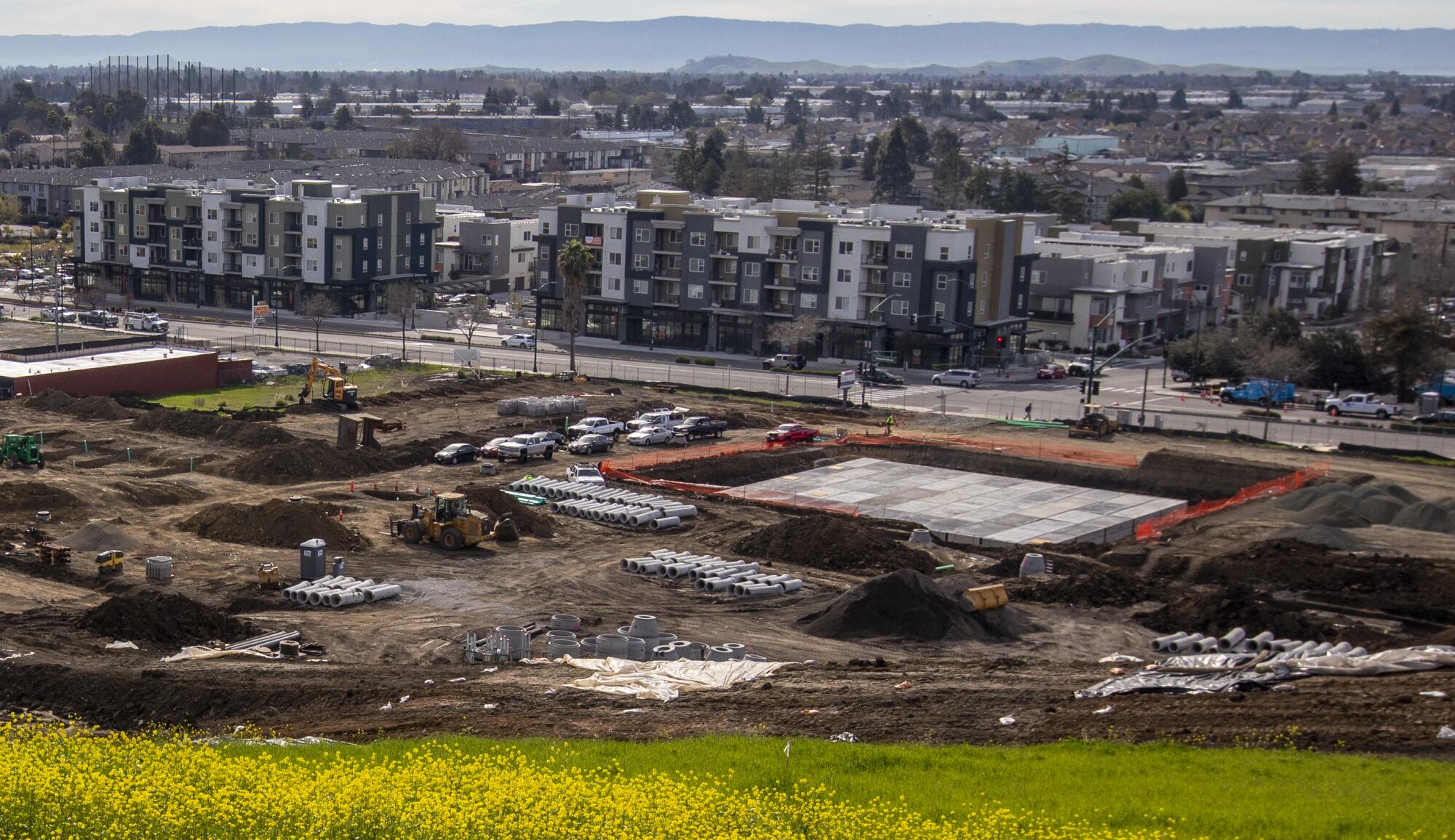
But public sentiment soured quickly. By the late 1960s, revolts against freeways erupted over the environmental destruction and community division they were causing. Activists and homeowners in Hayward and Union City, the community just south, sued to stop the 238 Freeway under new federal environmental and housing laws passed in response to the outcry. Their victory in 1971 halted all property acquisition, a death knell for the project, though it would take another four decades to finally die.
In the interim, state and local officials concocted various schemes to construct some version of the freeway, but every idea got tied up in litigation or ran out of money.
Tenants moved into the freeway properties, attracted by low rents. But the houses deteriorated as the state skimped on maintenance. The worst of them were boarded up, attracting squatters and thieves, creating eyesores along entire blocks.
Residents pushed back to no avail. In the early 1990s, one tenant activist died in a house fire after years of complaints about his home’s condition.

In Southern California, those living along the proposed 710 Freeway corridor were plunged into the same mess. Historic single-family Craftsmans, like the 110-year-old childhood home of famed chef Julia Child in Pasadena, are empty. Faulty wiring, structural decay and vermin infestations have made many dangerous and uninhabitable at a time the region is in desperate need for more housing.
Activists driven by the region’s affordable housing crisis and health demands to shelter at home during the COVID-19 pandemic have repeatedly attempted to occupy vacant, state-owned homes in El Sereno.
The decades-long uncertainty of these freeway projects, both north and south, have taken a psychic toll.
In Hayward, Ann E. Maris, 57, grew up in a three-bedroom Caltrans home with her mother and two siblings.
“Every time a vote came up, a new decision, we felt like we’d be evicted,” she said.
It took until 2010 — more than 50 years after planners first dreamed up the 238 Freeway — for the project to finally end. A legal settlement ratified that year gave tenants the chance to own the homes they’d be living in.
Maris’ mother, Beverly, was able to purchase her house. The first thing they did was literally put down roots, planting the fig and Meyer lemon trees on their property that they’d been forced to keep in pots while they were renting.
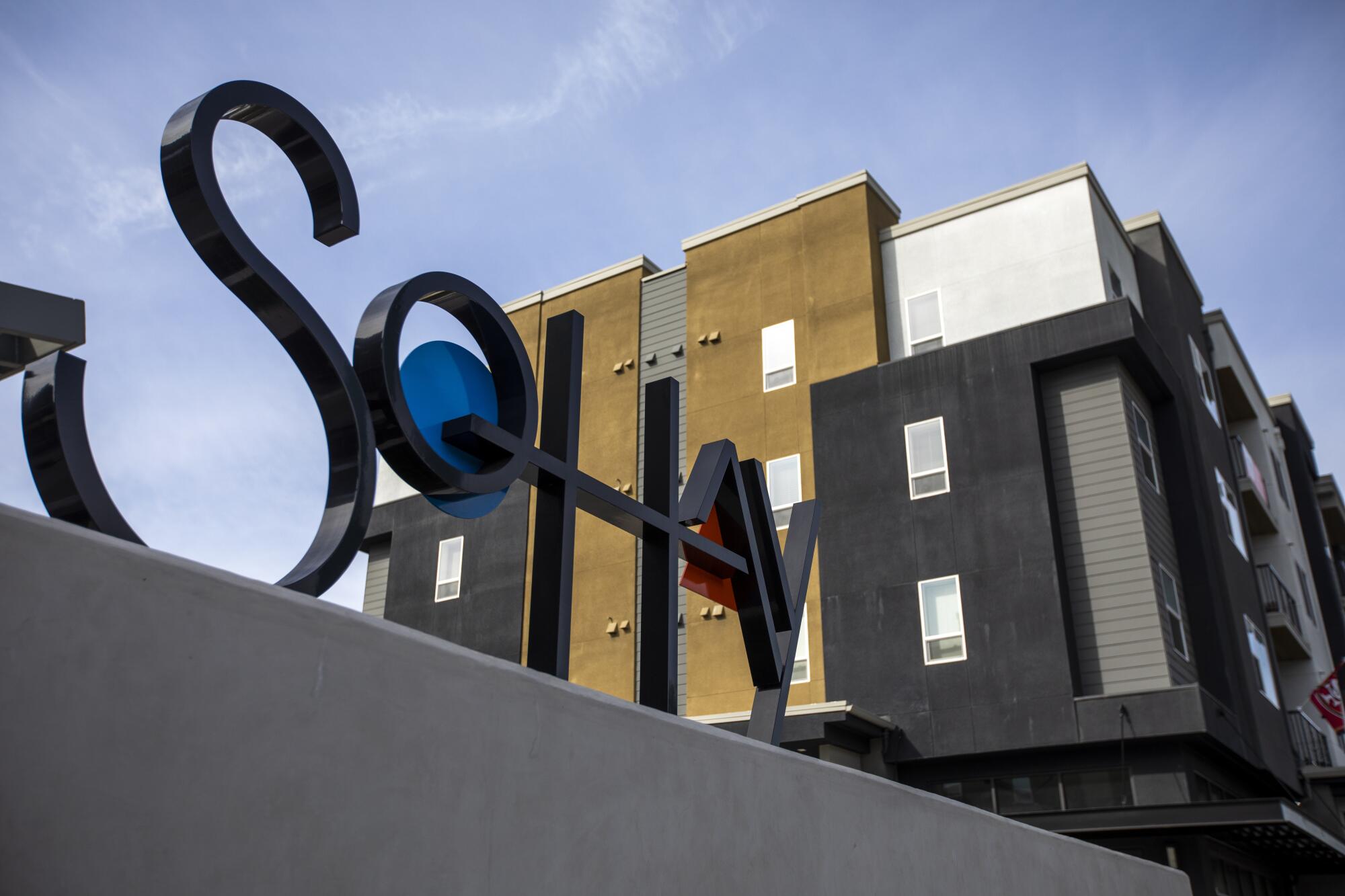
The state agreed to let Hayward sell the large parcels on its behalf, with the city retaining any profits in deals with developers. Plans call for a mix of apartments, condominiums and single-family homes totaling 1,500 new houses, with more than a quarter reserved for low-income residents. Each developer must link into a hiking trail that will run the entire freeway corridor, and the city already is using some of the proceeds to bolster homelessness services.
Construction crews are finishing a nearly 500-unit mixed-income apartment and townhouse project called “SoHay” within walking distance of a Bay Area Rapid Transit station.
“Right now, we have new communities of residents because of this process, which wouldn’t exist otherwise,” Hayward Mayor Barbara Halliday said.
Grand plans also define Southern California communities’ approach to revitalizing the 710 Freeway corridor lands. Los Angeles city officials are hoping to redevelop vacant lots and crumbling homes in El Sereno into more than 250 new or rehabilitated houses and low-income apartments. Their counterparts in South Pasadena want to acquire large historic homes there, using the proceeds from the sales to build more affordable housing elsewhere in the city. Caltrans expects to begin selling empty properties in the first half of this year.
Still, Hayward’s experience shows that quick action in Southern California is unlikely.
Twelve years after the road’s demise, the only large-scale housing project with current residents is SoHay. Eden Housing, a nonprofit developer, remains years away from opening two low-income housing projects, citing funding challenges and neighborhood pushback. Eden officials first approached Caltrans about building one 72-unit project in 2011, but they say it won’t open until 2025 at the earliest. Earlier this year, a developer who was planning an additional 300 homes on a former quarry site pulled out.
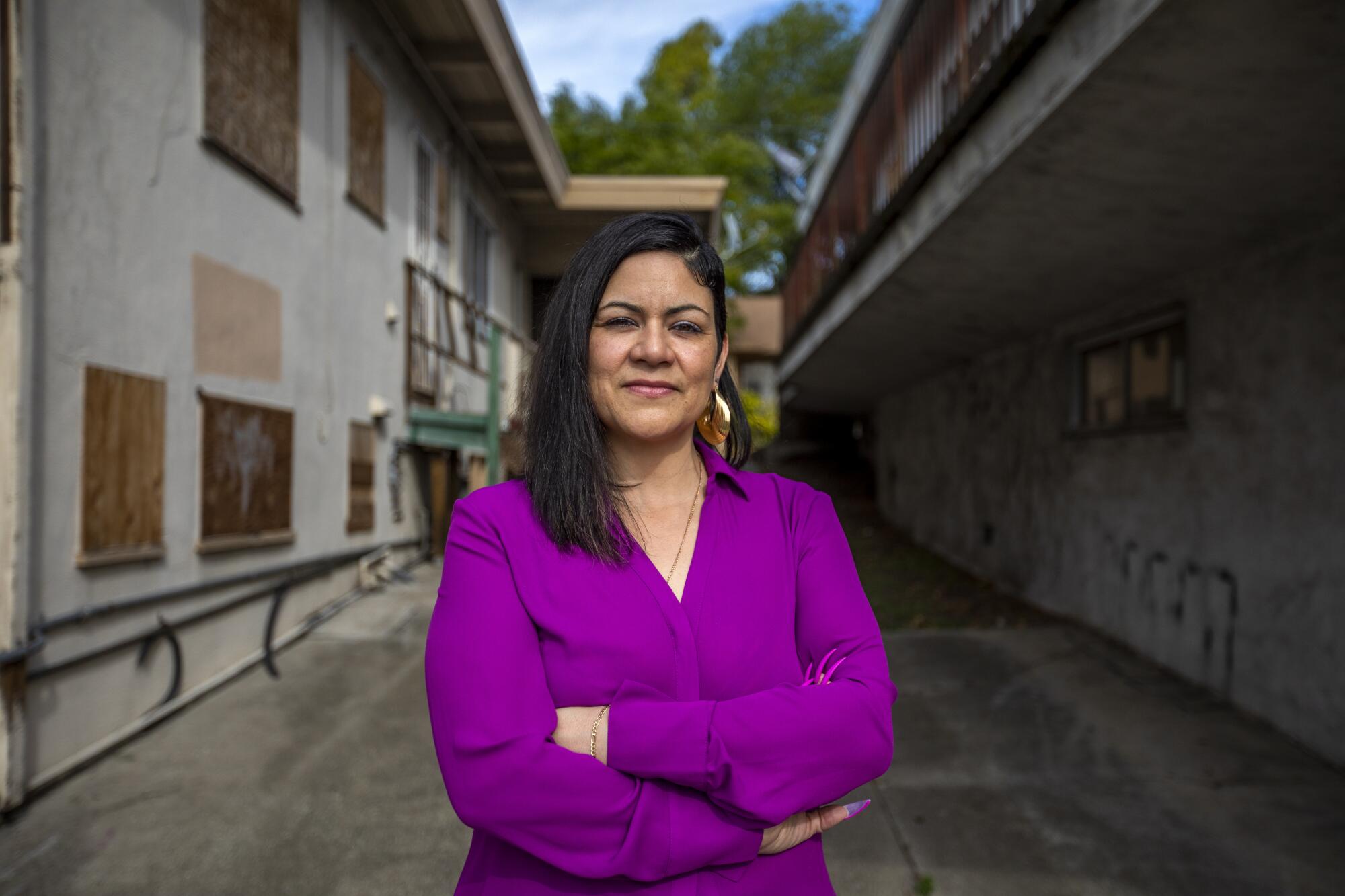

Ida Alvarez is frustrated by the pace after 12 years renting one-bedroom, state-owned apartments with her son. The state moved her from her initial unit after constant complaints about a mold infestation so pervasive that it covered the clothes in her dresser drawers.
Two of the four apartments in Alvarez’s complex now are boarded up. Squatters are constantly breaking into them, and she’ll occasionally wake up to find new graffiti sprayed onto the walls, she said.
Alvarez, who works in accounting for a private college, stays because she pays only $715 a month — an astoundingly cheap rent for the Bay Area — and she’s holding out hope for what might happen there. Another nonprofit developer is planning a new low-income complex on the site and has promised not to displace the residents. But there’s no timeline for when the project might occur.
“Why is this taking so long?” said Alvarez, 42. “There is a crisis with homelessness and especially with the pandemic making it worse for people.”
Many tenants were simply priced out when the single-family homes went up for sale. They couldn’t afford the necessary repairs or qualify for loans.
Some of the country’s largest recent highway expansions have inflicted another round of displacement in largely Black and Latino communities.
In the mid-1990s, Taunya DeYoung and her then-husband moved into a single-family home in the hills that relied on an old septic tank and had loads of problems. They were constantly pushing for Caltrans to make repairs. When state-hired workers finally came to fix a faulty heater, they found a dead possum inside it. When they came to fix a rotting deck, they tore it away entirely instead, leaving her with a door that opened to a 10-foot drop.
Still, DeYoung loved the home — the view was priceless — and was overjoyed when they finally had a chance to buy it. Then came the fine print. The city informed her she’d have to pay for neighborhood upgrades, including new sewer lines, through an assessment on the property that totaled more than $100,000 on top of the purchase price.
DeYoung, a travel guide, could not get a loan to cover it and reluctantly accepted a settlement to leave. She now lives in a duplex in Menlo Park that she rents from family, the settlement left untouched in an account she doubts she’ll ever use to buy a home.
“I’m probably never going to be able to buy in the Bay Area,” said DeYoung, 54. “That was my one and only best shot.”
A couple years ago, she drove by her old home and saw it had been demolished. It broke her heart.

For Frederick, 72, buying her home also came with challenges. She immediately had to pour $15,000 into foundation and other repairs and faces her own $50,000 assessment from the city.
But she felt as if she was acquiring something that was already part of her life. At Christmas, she’s squeezed a dozen family members inside, everyone enjoying the view.
“My home is my heart,” she said, “even while I was renting.”
City plans call for 74 new single-family homes to be built around her property. Frederick has savored her relative solitude but accepts that there’s a housing shortage in the Bay Area.
“I have to accept it as the reality of life if I’ve lived in Shangri-La for 30 years,” Frederick said.
Others, she said, should get to live there, too.
More to Read
Sign up for Essential California
The most important California stories and recommendations in your inbox every morning.
You may occasionally receive promotional content from the Los Angeles Times.

